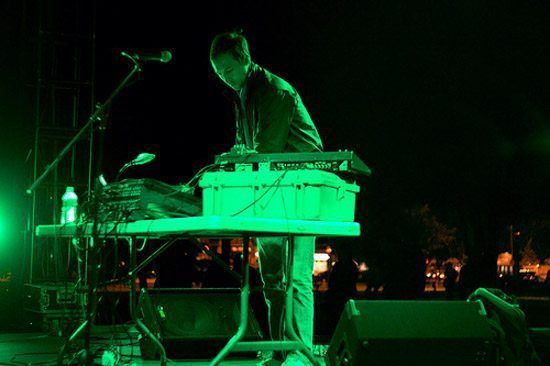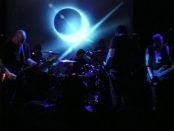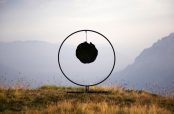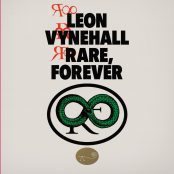Deeply entranced, I imagine the black and white noise which is resonating around the room as scattered photographs. These sepia toned images are of nothing and everything, of people I know and those I never did or will. Pictures fly around my head without purpose but with an intensity that is both classical and psychedelic.
This is what it is like to listen to Tim Hecker. A Canada based 'sound' artist and synthesis musician, since 1996 Tim Hecker has been attempting minor revolutions in what we have to come to know as music. His electronically strong ambient compositions are world renowned, even when originally under the techno and dance music pseudonym Jetone he set himself apart from the crowd. Releasing work under various record labels like Kranky, Alien8, Mille Plateaux, Room40, Force Inc, Staalplaat, and Fat Cat, he has built quite a reputation. He has recorded and produced music with the likes Christof Migone, Martin Tétreault, and Aidan Baker and other illustrious sound artists and noise installationists. However it was the ambient sounds which Hecker developed that really distinguished him, with tracks setting out to overwhelm and instil brave imaginings within listeners. Through this music he enabled new sub-genres to develop such as “cathedral electronic music” or the less fanciful “structured ambient”. With a techno-household name and a unique and popular audio aesthetic, it wasn’t long before Tim Hecker became a festival circuit staple. He has performed live at a host of international dance and performing arts festivals such as Barcelona’s Sonar, the Vancouver New Music Festival and Utrecht’s Impakt Festival, as well as many others.

The album ‘Rave Death, 1972’ is the epitome of Tim Hecker’s style, a choir of synth bombards you from start to finish with sensualising symmetry. The arc of the album is like a deep secret being buried, I’m not sure if it is my own, yours or his. Sweet sounding pulses with dark undertones, the architecture of this music is actually pretty simple but implies a complex truth. The album was recorded within a church in Reykjavik using a pipe organ as the core sound premise, this was a live recording but with immense studio craftsmanship. Encapsulating cathedral electronica, the album is about transcendental states and spiritual awakening. There is an enthralling climax on ‘Hatred on Music 1’, yet this music is anything but hateful. It does not feel as though you are being taken through another’s emotions but you are being shown your own. It is a mirror of noise.
Initially I would have liked to believe that this album might convey Hecker’s possible hatred for how dance music has become contrived and facile. I mean the very name of the album, ‘Rave Death, 1972’ and the names of the tracks indicate a distain for current waves of musical thinking or a desire to generate new ones. Yet knowing this artist’s history and on listening to the orchestral trance of the album, I believe it is more a nostalgic commentary than an ambient coup.
According to the label, ‘Ravedeath, 1972’ supposedly strives to confront issues of negativity and passivity surrounding musicality and the synthetic age. In this respect more could have been done, the album being basically a showcase for Hecker’s skill rather than a protest for or against the repudiation of dance music. Which is all well and good, that is the point of album releases after all. But when we aim for something we must at least attempt if not to succeed, and I find the lack of attempt here more off putting than any possible failure. This is my convoluted way of saying “do or do not, there is no try”.
As for my opinion of the music, well I find ambience to be graceful and insightful. Only true skill can pull it off with any real conviction and Tim Hecker has mastered this skill. Nevertheless I did find myself a little nonplussed. I wanted ‘Ravedeath, 1972’ to mean something more. It was like walking into an uninstalled white cube gallery, it had depth and potential but there was nothing to look at. Nothing to inspire me. Being a fan of progressive works, you can tell I’m serious when I say that this felt over-progressive and it had limited rise or tone diversity. The album was constrained by it’s own transcendentalism, a philosophical mouthful if there was any. I guess part of my dislike might be the descriptive methodologies associated with Tim Hecker’s work. Pernicious terms such as “tectonic colour plates” only lead to musical constructions which aim to be discs of moving shades (see what I’ve done here?), and not anything more substantial.
Outside of the artful hyperbole it has to be recognised that this record sets its sights high, making you consider the wider implications of music. It has all the trappings of a classic, but has become wound up in an anti-iconic frame for its release. It is a big record, tall musically and wide conceptually but sometimes in its depth it captures alienation rather than revolutionary coalescence. Yet credit where credit is due, overall I do rate this album, highly in fact. It is another melodically dissonant recording by a true master and I hope to encounter it in some geodesic dome next summer in the wee hours of the dawn.
(released 14th February 2011 on Kranky records)
Tim Hecker's Earlier Sound
TIM HECKER – APONDALIFA (SIDE A) by ROOM40

The aim of art is to represent not the outward appearance of things, but their inward significance. – Aristotle



















